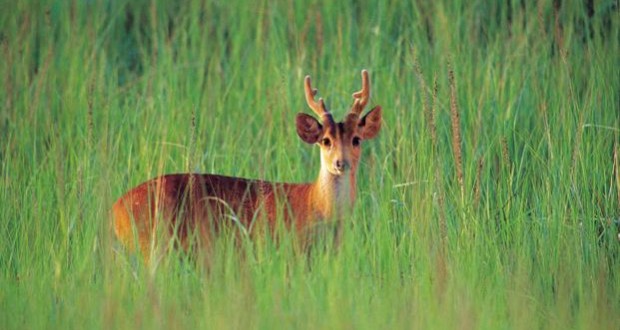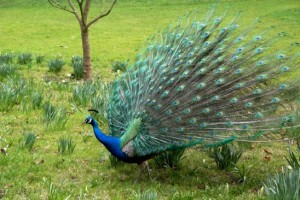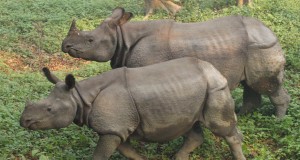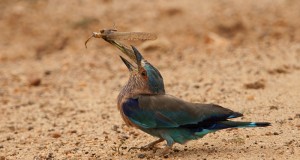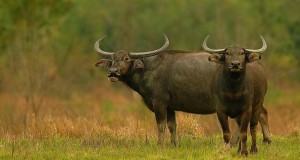ASSAM: Today’s state of Assam follows the course of the Brahmaputra river from the point where it leaves the Eastern Himalaya in Arunachal Pradesh until it turns south into Bangladesh. Traditionally known for its tea, its forests and its wildlife, Assam is a fascinating mix of industry (10 percent of India’s oil is produced near Duliajan), agriculture, history, religion, and great natural beauty. Some of Asia’s conservation successes have been in Assam. The Indian one-horned rhinoceros was on the brink of extinction 50 years ago but, thanks to proper management and experiments in translocation, its future now seems secure. The swamp deer and Asiatic wild buffalo have in recent years been equally threatened. In 1971 the hispid hare and the pigmy hog were rediscovered in the grasslands to the north after being thought extinct for about 30 years.
into Bangladesh. Traditionally known for its tea, its forests and its wildlife, Assam is a fascinating mix of industry (10 percent of India’s oil is produced near Duliajan), agriculture, history, religion, and great natural beauty. Some of Asia’s conservation successes have been in Assam. The Indian one-horned rhinoceros was on the brink of extinction 50 years ago but, thanks to proper management and experiments in translocation, its future now seems secure. The swamp deer and Asiatic wild buffalo have in recent years been equally threatened. In 1971 the hispid hare and the pigmy hog were rediscovered in the grasslands to the north after being thought extinct for about 30 years.
Permission for individual visitors to enter Assam is still difficult to get, but groups of six or more are getting permits without too much delay. Applications should be made to any Indian Embassy or High Commission abroad or direct to the Ministry of Home Affairs (Foreigners Wing), Lok Nayak Bahwan, Khan Market, New Delhi 110003. (Allow six to eight weeks.
Information can also be obtained by writing to 4 Reet Hazarika, Sheeba Travels, G.N. Bordoloi Road, Ambari, Guwahati 781001 (Tel: 22135).
There are two proposed biosphere reserves at Kaziranga and Manas.
Barnadi Wildlife Sanctuary
Established in 1980 to protect one of the few remaining habitats of the extremely elusive hispid hare and pigmy hog, this sanctuary has an area of only 10 sq miles (26 sq km) of grassland, subject to pressure from local villagers cutting grass and cattle grazing. Elephant, tiger and leopard are also seen.
Permission: DFO, West. Assam WL Division, PO Tezpur, Dist: Sonitp, Assam.
Nearest town and Rail: Tangla (25 miles)
Air: Guwahati (87 miles/140 km)
Garamani Sanctuary
Established in 1952, this small sanctuary has a few tigers, leopards, elephants (which cross from the Rengma Hills to the foothills of the Naga Hills) and other mammals.
Best time to visit: Nov.-Mar. Accommodation: 1 resthouse
Permission: DFO, Golaghat Division, PO Golaghat, Dist: Jorhat, Assam.
Nearest town & Rail: Golaghat (15 miles)
Air: Jorhat (44 miles/70 km)
Kaziranga N.P
In 1908, when the area was declared a forest reserve there were only about a dozen rhinos left in it. In 1926, Kaziranga became a game sanctuary and in 1974 it was declared a national park. It is justly famous, but not only for rhino but also for wild buffalo, the magnificent swamp deer and hog deer. Tiger, wild boar, Hoolock gibbon, capped langur and ratel (hog badger) are among the other animals seen. Mihimukh is a good viewing area. Visitors facilities are available and well-trained elephants can be hired. There is a good network of fair weather roads.
Best time to visit: Nov.-Mar.
Accommodation: forest resthouses and bungalows; Kaziranga Forest Lo dge (ITDC) (airconditioned rooms, bar, restaurant, Cable: RHINOWALK)
dge (ITDC) (airconditioned rooms, bar, restaurant, Cable: RHINOWALK)
Permission: Director, Kaziranga N.P., PO Bokakhat, Dist: Jorhat, Assam 785612 Nearest town: Bokakhat (l4miles/23 km)
Rail & Air: Jorhat (59 miles/95 km)
Laokhowa Sanctuary
Established in 1979, this sanctuary has a small population of rhino and wild buffalo. The habitat is similar to Kaziranga, with areas of swampy flats, tall grasses and scattered trees.
Accommodation: 1 resthouse with 24 beds
Permission: DFO, Nagaon Division, PO Nagaon, Assam.
Nearest town & Rail: Nagaon (12 miles)
Air: Guwahati (106 miles/170 km)
Manas Sanctuary and Tiger Reserve
Established in 1928 as a small reserve, the area now protected is over 1094 sq miles (2840 sq km), of which 151 sq miles (391 sq km) form the core area and come under Project Tiger. The protected area continues north into the Bhutan foothills. Visitors can cross into the Bhutanese sanctuary. The park lies across two rivers (the Ivlanas and its tributary, the Hakua) with an unparalleled variation of habitat for such a narrow strip. The scenery of Manas is considered by many the most attractive of any Indian park. To the south are grasslands with the rivers, with their pebble-banks and islands, spreading as they leave the great forests on the Bhutan hills.
On the Indian side, the forests are mixed deciduous with open glades. Manas holds viable populations of 19 of India’s most endangered animals. Great herds of elephant (up to 2000 in the area) migrate across the border. Rhino, wild buffalo, gaur, swamp deer, capped langur and clouded leopard are just a few of the mammal species. The tiger population here is perhaps the most dense of all the tiger reserves. Pigmy hog and hispid hare are also found here but rarely seen. On the Bhutan side, the only extant groups of golden langur are found.br The rich birdlife is distinctive and abundant. Transport in the park, riding elephants and boats on the rivers are available.
Best time to visit: Nov.-Mar.
Accommodation: Tourist Lodge and forest bungalows. at Ivlothanguri
Permission: The Field Director-Project Tiger, PO Barpeta Road, Dist: Barpeta, Assam 781315br
Nearest town & Rail: Barpeta Road (25 miles/41 km)
Air: Guwahati (116 miles/186 km)
Orang Sanctuary
One of India’s oldest protected areas, this sanctuary 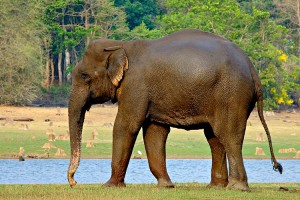 of swampy grassland on the north bank of the Brahmaputra holds rhino, wild buffalo, swamp deer, elephant and tiger, among others.
of swampy grassland on the north bank of the Brahmaputra holds rhino, wild buffalo, swamp deer, elephant and tiger, among others.
Best time to visit: Nov.-Apr.
Accommodation: 1 resthousebr
Permission: DFO, West. Assam WL Division, PO Tezpur, Dist: Sonitpur, Assam.
Nearest town & Rail: Tezpur (53 miles)
Sonai Rupai Sanctuary
In the Dooai grasslands at the base of the Dafla hill, this park covers about 67 sq miles (175 sq km). Although not seen since about 1940, the area possibly still holds pigmy hog and hispid hare which are still known to be in the Rowta Reserve Forest to the west and the Balipara Reserve Forest to the east. Tiger, a few swamp deer, buffalo and hog deer are found.
Best time to visit: Nov.-Mar.
Permission: DFO, West. Assam WL Division, PO Temper , Dist: Sonitpur, Assam.
Nearest town & Air: Tezpur (47miles) Rail: Rangapara (34 miles/55 km)

